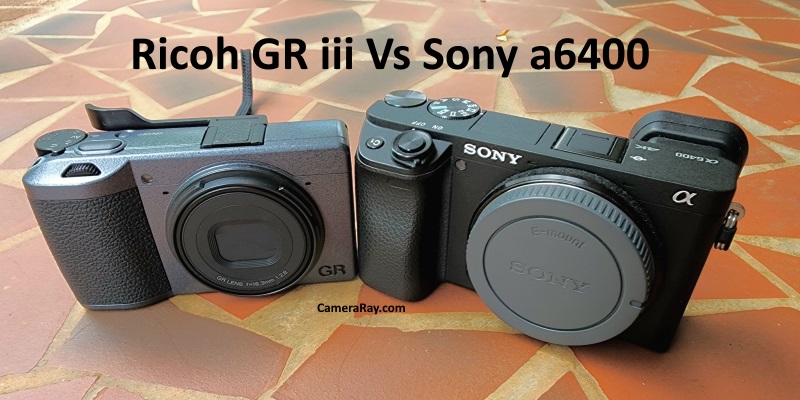
Sony a6400 vs Ricoh GR iii: Choosing the Best Camera for Your Needs.
When it comes to choosing a digital camera, the decision often comes down to individual needs, preferences, and intended usage. Two popular options on the market are the Sony a6400 and the Ricoh GR iii. Both of these cameras are powerful tools in their own right, yet they each have unique features that might sway you in one direction or the other.
The Sony a6400 is a mirrorless camera with an APS-C sensor, part of Sony’s illustrious Alpha line. On the other hand, the Ricoh GR iii is a compact digital camera equipped with an APS-C sensor that’s famous for its sleek design and excellent image quality. Both offer high-resolution photography, but their functionality, design, and additional features cater to different types of photographers.
First, let’s examine the Sony a6400. This camera boasts a 24.2 MP sensor and an impressive autofocus system, which includes 425 phase-detection points covering approximately 84% of the image area. This advanced autofocus technology allows for incredibly fast focus (0.02 seconds), making it perfect for action, sports photography, or any situation where your subject is rapidly moving. Sony’s ‘Real-Time Tracking’ and ‘Real-Time Eye AF’ features are also a boon, as they enable accurate tracking of moving subjects and enhanced eye detection, respectively.
In terms of video, the a6400 supports 4K video recording and includes a 180-degree tiltable LCD touch screen, making it a compelling option for vloggers or anyone interested in videography. Additionally, it has an electronic viewfinder, a feature that some photographers prefer for its ability to offer a clear preview of what the final image will look like.
On the downside, the a6400 doesn’t have in-body image stabilization (IBIS), which can be a drawback for handheld photography or in low-light conditions. Furthermore, its compact design results in a small grip that might be uncomfortable for some users during prolonged use.
In contrast, the Ricoh GR iii is renowned for its compact design, portability, and exceptional image quality. With a 24.2 MP APS-C sensor, it matches the Sony a6400 in terms of resolution. However, the GR iii stands out with its 28mm equivalent f/2.8 lens, which makes it a fantastic choice for street photography, travel, and everyday casual use.
The GR iii comes with IBIS, a feature that compensates for camera shake and facilitates handheld shooting in various conditions. It also offers a macro mode, allowing you to get as close as 6cm to your subject, which is not something the a6400 can boast.
Unlike the a6400, the GR iii doesn’t have a viewfinder, relying instead on the rear LCD for composing shots. It also falls behind the a6400 in terms of autofocus performance and doesn’t support 4K video, which could be deal-breakers for some users.
So, which one is the better camera for you? The answer depends on your needs as a photographer.
If you’re into action, sports photography, or videography and need a camera with a speedy and accurate autofocus system, the Sony a6400 is an excellent choice. It’s also a better option for vloggers due to its 4K video capabilities and a 180-degree tiltable LCD screen.
On the other hand, if you prioritize portability, image stabilization, and enjoy street and travel photography, you might find the Ricoh GR iii more suitable. Its compact design, IBIS, and the 28mm equivalent lens make it a powerful tool for capturing life on the go.
In conclusion, both the Sony a6400 and the Ricoh GR iii are high-quality cameras that offer unique features. Before making a decision, consider the type of photography you most enjoy and the features that are most important to you.
Perhaps the main differentiation lies in their respective form factors and intended use scenarios. The a6400, with its advanced autofocus, interchangeable lens capability, and superior video functionality, is a versatile tool that lends itself well to various professional and semi-professional applications. This makes it particularly appealing to those who wish to cover a broad spectrum of photography styles and situations or who are looking to delve into videography.
The Ricoh GR iii, on the other hand, has carved a unique niche for itself. Its combination of compact design, high-quality lens, and image stabilization is not commonly found in cameras of this size. It’s a potent tool for those who value portability and quick, spontaneous shooting – street photographers, travel enthusiasts, and those who prefer a minimalist approach to their photography will find much to love here.
More Ricoh GR iii info here.
In terms of user interface and handling, both cameras have their strengths. Sony’s menu system can be complex but offers a high degree of customization. Ricoh’s interface is more straightforward, aligning with its minimalist ethos, but it might lack some of the granular control over settings that some advanced users may desire.
Price-wise there isn’t a significant difference between the two cameras, but it’s always worth checking the most recent prices and considering what value each camera offers you in terms of its features.
In the end, the choice between the Sony a6400 and the Ricoh GR iii is not necessarily about which camera is objectively ‘better’. Instead, it’s about which camera better suits your needs, preferences, and photography style. Whichever you choose, both are capable of delivering exceptional results and can be a valuable addition to your photography kit.